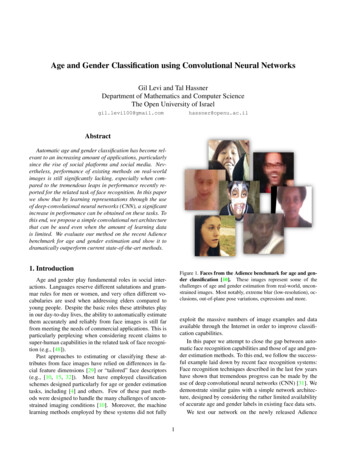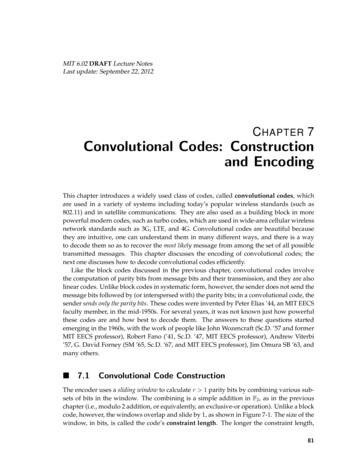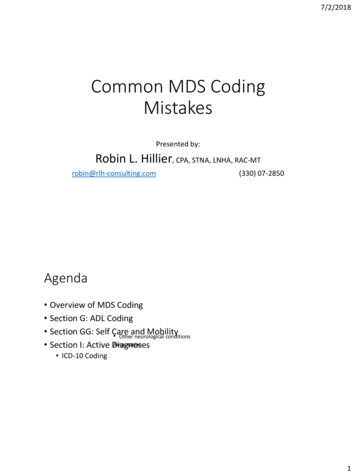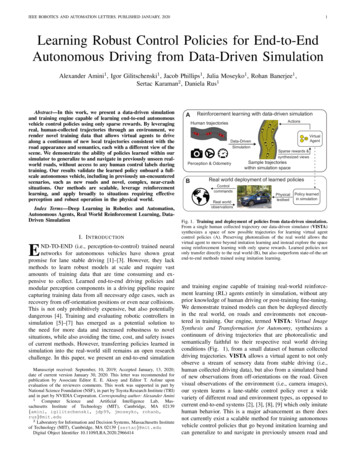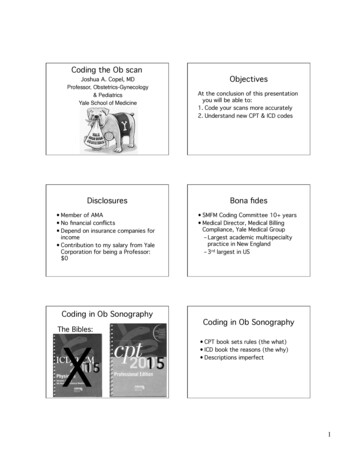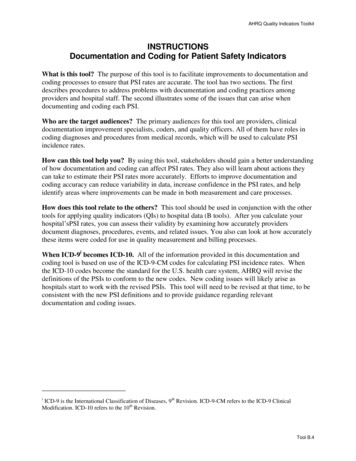
Transcription
MIT 6.02 DRAFT Lecture NotesFall 2010 (Last update: October 4, 2010)Comments, questions or bug reports?Please contact 6.02-staff@mit.eduL ECTURE 8Convolutional CodingThis lecture introduces a powerful and widely used class of codes, called convolutionalcodes, which are used in a variety of systems including today’s popular wireless standards (such as 802.11) and in satellite communications. Convolutional codes are beautifulbecause they are intuitive, one can understand them in many different ways, and there isa way to decode them so as to recover the mathematically most likely message from amongthe set of all possible transmitted messages. This lecture discusses the encoding; the nextone discusses how to decode convolutional codes efficiently. 8.1OverviewConvolutional codes are a bit like the block codes discussed in the previous lecture inthat they involve the transmission of parity bits that are computed from message bits.Unlike block codes in systematic form, however, the sender does not send the messagebits followed by (or interspersed with) the parity bits; in a convolutional code, the sendersends only the parity bits.The encoder uses a sliding window to calculate r 1 parity bits by combining varioussubsets of bits in the window. The combining is a simple addition in F2 , as in the previouslectures (i.e., modulo 2 addition, or equivalently, an exclusive-or operation). Unlike a blockcode, the windows overlap and slide by 1, as shown in Figure 8-1. The size of the window,in bits, is called the code’s constraint length. The longer the constraint length, the largerthe number of parity bits that are influenced by any given message bit. Because the paritybits are the only bits sent over the channel, a larger constraint length generally impliesa greater resilience to bit errors. The trade-off, though, is that it will take considerablylonger to decode codes of long constraint length, so one can’t increase the constraint lengtharbitrarily and expect fast decoding.If a convolutional code that produces r parity bits per window and slides the windowforward by one bit at a time, its rate (when calculated over long messages) is 1/r. Thegreater the value of r, the higher the resilience of bit errors, but the trade-off is that a proportionally higher amount of communication bandwidth is devoted to coding overhead.In practice, we would like to pick r and the constraint length to be as small as possible1
2LECTURE 8. CONVOLUTIONAL CODINGFigure 8-1: An example of a convolutional code with two parity bits per message bit (r 2) and constraintlength (shown in the rectangular window) K 3.while providing a low enough resulting probability of a bit error.In 6.02, we will use K (upper case) to refer to the constraint length, a somewhat unfortunate choice because we have used k (lower case) in previous lectures to refer to thenumber of message bits that get encoded to produce coded bits. Although “L” might bea better way to refer to the constraint length, we’ll use K because many papers and documents in the field use K (in fact, most use k in lower case, which is especially confusing).Because we will rarely refer to a “block” of size k while talking about convolutional codes,we hope that this notation won’t cause confusion.Armed with this notation, we can describe the encoding process succinctly. The encoderlooks at K bits at a time and produces r parity bits according to carefully chosen functionsthat operate over various subsets of the K bits.1 One example is shown in Figure 8-1,which shows a scheme with K 3 and r 2 (the rate of this code, 1/r 1/2). The encoderspits out r bits, which are sent sequentially, slides the window by 1 to the right, and thenrepeats the process. That’s essentially it.At the transmitter, the only remaining details that we have to worry about now are:1. What are good parity functions and how can we represent them conveniently?2. How can we implement the encoder efficiently?The rest of this lecture will discuss these issues, and also explain why these codes arecalled “convolutional”. 8.2Parity EquationsThe example in Figure 8-1 shows one example of a set of parity equations, which governthe way in which parity bits are produced from the sequence of message bits, X. In thisexample, the equations are as follows (all additions are in F2 )):p0 [n] x[n] x[n 1] x[n 2]p1 [n] x[n] x[n 1]1(8.1)By convention, we will assume that each message has K 1 “0” bits padded in front, so that the initialconditions work out properly.
3SECTION 8.2. PARITY EQUATIONSAn example of parity equations for a rate 1/3 code isp0 [n] x[n] x[n 1] x[n 2]p1 [n] x[n] x[n 1]p2 [n] x[n] x[n 2](8.2)In general, one can view each parity equation as being produced by composing the message bits, X, and a generator polynomial, g. In the first example above, the generator polynomial coefficients are (1, 1, 1) and (1, 1, 0), while in the second, they are (1, 1, 1), (1, 1, 0),and (1, 0, 1).We denote by gi the K-element generator polynomial for parity bit pi . We can thenwrite pi as follows:k 1 pi [n] (gi [j]x[n j]) mod 2.(8.3)j 0The form of the above equation is a convolution of g and x—hence the term “convolutional code”. The number of generator polynomials is equal to the number of generatedparity bits, r, in each sliding window. 8.2.1An ExampleLet’s consider the two generator polynomials of Equations 8.1 (Figure 8-1). Here, the generator polynomials areg0 1, 1, 1g1 1, 1, 0(8.4)If the message sequence, X [1, 0, 1, 1, . . .] (as usual, x[n] 0 n 0), then the paritybits from Equations 8.1 work out to bep0 [0] (1 0 0) 1p1 [0] (1 0) 1p0 [1] (0 1 0) 1p1 [1] (0 1) 1p0 [2] (1 0 1) 0p1 [2] (1 0) 1p0 [3] (1 1 0) 0p1 [3] (1 1) 0.(8.5)Therefore, the parity bits sent over the channel are [1, 1, 1, 1, 0, 0, 0, 0, . . .].There are several generator polynomials, but understanding how to construct goodones is outside the scope of 6.02. Some examples (found by J. Busgang) are shown inTable 8-1.
4LECTURE 8. CONVOLUTIONAL CODINGConstraint 11011110011001Table 8-1: Examples of generator polynomials for rate 1/2 convolutional codes with different constraintlengths.Figure 8-2: Block diagram view of convolutional coding with shift registers. 8.3Two Views of the Convolutional EncoderWe now describe two views of the convolutional encoder, which we will find useful inbetter understanding convolutional codes and in implementing the encoding and decoding procedures. The first view is in terms of a block diagram, where one can constructthe mechanism using shift registers that are connected together. The second is in terms ofa state machine, which corresponds to a view of the encoder as a set of states with welldefined transitions between them. The state machine view will turn out to be extremelyuseful in figuring out how to decode a set of parity bits to reconstruct the original messagebits. 8.3.1Block Diagram ViewFigure 8-2 shows the same encoder as Figure 8-1 and Equations (8.1) in the form of a blockdiagram. The x[n i] values (here there are two) are referred to as the state of the encoder.The way to think of this block diagram is as a “black box” that takes message bits in andspits out parity bits.Input message bits, x[n], arrive on the wire from the left. The box calculates the paritybits using the incoming bits and the state of the encoder (the k 1 previous bits; 2 in thisexample). After the r parity bits are produced, the state of the encoder shifts by 1, with x[n]
SECTION 8.3. TWO VIEWS OF THE CONVOLUTIONAL ENCODER5Figure 8-3: State machine view of convolutional coding.taking the place of x[n 1], x[n 1] taking the place of x[n 2], and so on, with x[n K 1]being discarded. This block diagram is directly amenable to a hardware implementationusing shift registers. 8.3.2State Machine ViewAnother useful view of convolutional codes is as a state machine, which is shown in Figure 8-3 for the same example that we have used throughout this lecture (Figure 8-1).The state machine for a convolutional code is identical for all codes with a given constraint length, K, and the number of states is always 2K 1 . Only the pi labels change depending on the number of generator polynomials and the values of their coefficients. Eachstate is labeled with x[n 1]x[n 2] . . . x[n K 1]. Each arc is labeled with x[n]/p0 p1 . . .In this example, if the message is 101100, the transmitted bits are 11 11 01 00 01 10.This state machine view is an elegant way to explain what the transmitter does, and alsowhat the receiver ought to do to decode the message, as we now explain. The transmitterbegins in the initial state (labeled “STARTING STATE” in Figure 8-3) and processes themessage one bit at a time. For each message bit, it makes the state transition from thecurrent state to the new one depending on the value of the input bit, and sends the paritybits that are on the corresponding arc.The receiver, of course, does not have direct knowledge of the transmitter’s state transitions. It only sees the received sequence of parity bits, with possible corruptions. Its task isto determine the best possible sequence of transmitter states that could have producedthe parity bit sequence. This task is called decoding, which we will introduce next, andthen study in more detail in the next lecture.
6LECTURE 8. CONVOLUTIONAL CODING 8.4The Decoding ProblemAs mentioned above, the receiver should determine the “best possible” sequence of transmitter states. There are many ways of defining “best”, but one that is especially appealingis the most likely sequence of states (i.e., message bits) that must have been traversed (sent)by the transmitter. A decoder that is able to infer the most likely sequence is also called amaximum likelihood decoder.Consider the binary symmetric channel, where bits are received erroneously with probability p 1/2. What should a maximum likelihood decoder do when it receives r? Weshow now that if it decodes r as c, the nearest valid codeword with smallest Hammingdistance from r, then the decoding is a maximum likelihood one.A maximum likelihood decoder maximizes the quantity P (r c); i.e., it finds c so that theprobability that r was received given that c was sent is maximized. Consider any codewordc̃. If r and c̃ differ in d bits (i.e., their Hamming distance is d), then P (r c) pd (1 p)N d ,where N is the length of the received word (and also the length of each valid codeword).It’s more convenient to take the logarithm of this conditional probaility, also termed thelog-likelihood:2log P (r c̃) d log p (N d) log(1 p) d logp N log(1 p).1 p(8.6)pIf p 1/2, which is the practical realm of operation, then 1 p 1 and the log term isnegative (otherwise, it’s non-negative). As a result, minimizing the log likelihood boilsdown to minimizing d, because the second term on the RHS of Eq. (8.6) is a constant.A simple numerical example may be useful. Suppose that bit errors are independentand identically distribute with a BER of 0.001, and that the receiver digitizes a sequenceof analog samples into the bits 1101001. Is the sender more likely to have sent 1100111or 1100001? The first has a Hamming distance of 3, and the probability of receiving thatsequence is (0.999)4 (0.001)3 9.9 10 10 . The second choice has a Hamming distance of1 and a probability of (0.999)6 (0.001)1 9.9 10 4 , which is six orders of magnitude higherand is overwhelmingly more likely.Thus, the most likely sequence of parity bits that was transmitted must be the one withthe smallest Hamming distance from the sequence of parity bits received. Given a choiceof possible transmitted messages, the decoder should pick the one with the smallest suchHamming distance.Determining the nearest valid codeword to a received word is easier said than donefor convolutional codes. For example, see Figure 8-4, which shows a convolutional codewith k 3 and rate 1/2. If the receiver gets 111011000110, then some errors have occurred,because no valid transmitted sequence matches the received one. The last column in theexample shows d, the Hamming distance to all the possible transmitted sequences, withthe smallest one circled. To determine the most-likely 4-bit message that led to the paritysequence received, the receiver could look for the message whose transmitted parity bitshave smallest Hamming distance from the received bits. (If there are ties for the smallest,we can break them arbitrarily, because all these possibilities have the same resulting post2The base of the logarithm doesn’t matter to us at this stage, but traditionally the log likelihood is definedas the natural logarithm (base e).
7SECTION 8.5. THE TRELLIS AND DECODING THE 0d64Most likely: 1011Figure 8-4: When the probability of bit error is less than 1/2, maximum likelihood decoding boils downto finding the message whose parity bit sequence, when transmitted, has the smallest Hamming distanceto the received sequence. Ties may be broken arbitrarily. Unfortunately, for an N -bit transmit sequence,there are 2N possibilities, which makes it hugely intractable to simply go through in sequence becauseof the sheer number. For instance, when N 256 bits (a really small packet), the number of possibilitiesrivals the number of atoms in the universe!coded BER.)The straightforward approach of simply going through the list of possible transmit sequences and comparing Hamming distances is horribly intractable. The reason is that atransmit sequence of N bits has 2N possible strings, a number that is simply too largefor even small values of N , like 256 bits. We need a better plan for the receiver to navigatethis unbelievable large space of possibilities and quickly determine the valid message withsmallest Hamming distance. We will study a powerful and widely applicable method forsolving this problem, called Viterbi decoding, in the next lecture. This decoding methoduses a special structure called the trellis, which we describe next. 8.5The Trellis and Decoding the MessageThe trellis is a structure derived from the state machine that will allow us to develop anefficient way to decode convolutional codes. The state machine view shows what happens
8LECTURE 8. CONVOLUTIONAL CODINGFigure 8-5: The trellis is a convenient way of viewing the decoding task and understanding the time evolution of the state machine.at each instant when the sender has a message bit to process, but doesn’t show how thesystem evolves in time. The trellis is a structure that makes the time evolution explicit.An example is shown in Figure 8-5. Each column of the trellis has the set of states; eachstate in a column is connected to two states in the next column—the same two states inthe state diagram. The top link from each state in a column of the trellis shows what getstransmitted on a “0”, while the bottom shows what gets transmitted on a “1”. The pictureshows the links between states that are traversed in the trellis given the message 101100.We can now think about what the decoder needs to do in terms of this trellis. It gets asequence of parity bits, and needs to determine the best path through the trellis—that is,the sequence of states in the trellis that can explain the observed, and possibly corrupted,sequence of received parity bits.The Viterbi decoder finds a maximum likelihood path through the Trellis. We will studyit in the next lecture.
Convolutional codes are beautiful because they are intuitive, one can understand them in many different ways, and there is a way to decode them so as to recover the mathematically most likely message from among . Table 8-1: Examples of generator polynomials for rate 1/2 convolutional codes with different constraint lengths. Figure 8-2: Block .
